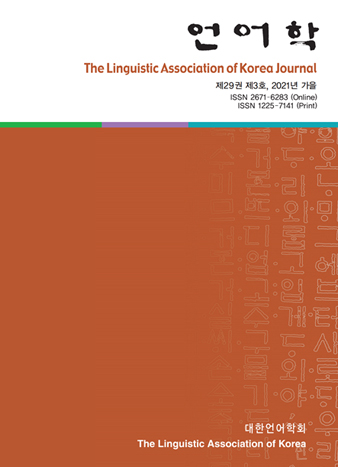대한언어학회 전자저널
29권 3호 (2021년 9월)
- 소셜빅데이터를 활용한 신조어 ‘개-’의 원형 연구
-
오효정 · 김종혁
Pages : 21-40
Abstract
Oh, Hyo-Jung & Kim, Chonghyuck. (2021). Probing the origin of the Korean adverbial kay- using data from Twitter. The Linguistic Association of Korea Journal, 29(3), 21-40. Traditionally, the word kay dog had been used as a prefix in Korean boosting the negative sense of the noun that it attaches to, as in kay-kosayng worthless extreme hardship. Around 2010, however, a morpheme, which looks exactly the same as prefix kay-, began to be used among younger generations as an adverbial expression, freely combining with various sorts of categories which have gradable meanings. This new adverbial kay has thereafter been viewed as an evolved variant of prefix kay- in the Korean literature. Recently, however, Im (2015) rejects this standard view about the origin of adverbial kay, and argues that it has nothing to do with prefix kay- as it derives from khap cap(tain) through the intermediate form khay. In this article, we probe the origin of adverbial kay using the data we collected from Twitter. Usage patterns that emerge from our analysis of the data containing khap and khay strongly indicate, contra Im (2015), (i) that khap cannot be the origin of adverbial kay and that khay can neither be its predecessor. Rather, the usage patterns match up to the expectations held by the standard view that adverbial kay originates from prefix kay.
Keywords
# 두어 ‘개’(prefix kay) # 신조어 ‘개’(adverbial kay) # 캡(cap(tain)) # 캐(khay) # 트위터 (Twitter)
References
- 강희숙. (2012). 통신 언어에 나타난 역문법화 현상 고찰 - 접두사 ‘개’의 용법을 중심으 로. 한민족어문학, 61, 61-87.
- 김정선, 이필영, 김태경, 이삼형, 장경희, 전은진. (2011). 청소년 입말에 나타난 비속어, 유행어, 은어 사용 실태. 한국언어문학, 77, 285-324.
- 김정선, 이필영, 김태경, 이삼형, 장경희, 전은진. (2013). 청소년 입말에 나타난 비속어 와 공격적 언어 표현 사용 실태 조사. 국어교육, 140, 153-181.
- 김태경, 장경희, 김정선, 이삼형, 이필영, 전은진. (2012). 청소년의 비속어, 욕설, 은어, 유행어 사용 실태와 언어 의식 연구. 국제어문, 54, 43-93.
- 노명희. (2013). 국어의 탈문법화 현상과 단어화. 국어학, 67, 107-143.
- 손평호. (2014). ‘개-’의 생산성과 범주 설정의 문제 – 신어 ‘개+X’ 유형을 중심으로. 우리 말연구, 39, 85-116.
- 오효정, 김종혁. (2021). 트위터에 나타난 접두어 ‘개-’의 사용 양상. 언어학, 29(1), 1-23. 임현열. (2015). 신조어에서 나타나는 어형 변화의 한 양상 - 정도부사 ‘캡(<Captain) > 캐 > 개’의 변화를 중심으로. 어문론집, 63, 111-136.
- 장경현. (2019). 신조어 접사의 형태·의미 특성 연구. 열린정신 인문학연구, 20(1), 311-336.
- 장부리. (2012). 한중 통신언어의 문법화와 역문법화의 비교 연구. 조선대학교 석사학위 논문.
- 전은진, 이삼형, 김정선, 김태경, 이필영, 장경희. (2011). 문자 언어에 나타난 청소년 언 어 실태 연구. 청람어문교육, 43, 371-406
- 정상준, 윤보현, 오효정. (2019). 언어 네트워크 기반 대통령기록물 관련 이슈 및 매체별 특성 분석. 한국비블리아학회지, 30(1), 181-207.
- 표준국어대사전. (2020). 국립국어원. 온라인주소 https://stdict.korean.go.kr/ main/main.do 홍달오. (2014). 접두사의 준부사화 경향에 대한 고찰 접두사 ‘개’를 중심으로. 언어, 39(1), 231-249.
- Oh, H. J., Kim, C. H., & Jeon, J. G. (2020). Public sense of water fluoridation as reflected on Twitter 2009-2017. Journal of Dental Research, 99(1), 11-17.
- Online Etymology Dictionary. (2001). damn(v.), Retrieved July 15, 2021, from https://www.etymonline.com/word/damn
